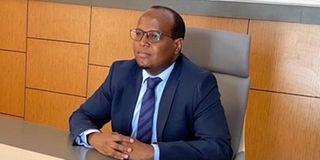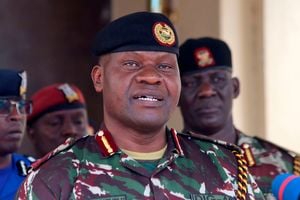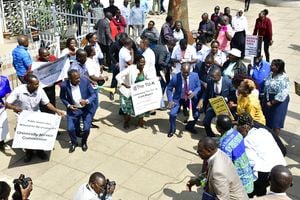Mustafa Sheik: Why Africa should improve its Country Code Top-Level Domains

Executive Director of the Somali Network Information Centre Mustafa Yasin Sheik.
Long known as a drought-stricken and war-torn country, Somalia is fast climbing the digital economy ladder. In the past two years, the country has ranked in the top ten in the global Mobile Internet Affordability Index which has prompted high shipments of affordable smartphones. Sphone penetration as a percentage of population reached 48.8 per cent in 2019 in Somalia, according to the World Bank.
After 30 years, last November, it revived its national payments system with a revamped digital operability. Mobile money business is booming as the country taps on technology to build a rosy future. But how does Somalia rank in terms of Country Code Top-Level Domains (ccTLDs) which determine a country’s brand strength on the internet? What efforts is it putting in place to get the domain ‘.so’ popular in the interwebs? Executive Director of the Somali Network Information Centre (SONIC) and Former Senior Advisor in the Ministry of Communication and Technology Mr Mustafa Yasin Sheik spoke to Nation’s tech journalist Faustine Ngila.
1. What exactly are ccTLDs?
A Country Code Top-Level Domain is the name in the Internet that is reserved for a country or territory. Every sovereign state has its own two-letter code that defines its country code on the internet. For instance’.uk’ denotes the United Kingdom, ‘.so’ is for Somalia, ‘.ke’ means it’s a Kenyan website or ‘.ng’ which identifies Nigeria. But note that some companies and organizations often choose to use top-level domain names like ‘.com’, ‘.net’, ‘.it’ or ‘.org’ rather than using their country's ccTLD. like tech companies use ‘.io’.
Second-Level Domain (SLD) refers to a domain that is directly below a top-level domain. For example, in ‘gifting.so’, ‘gifting’ is the second-level domain of the ‘.so’ ccTLD. A subdomain, on the other hand, is the domain part of another main domain. For example, for our ‘gifting.so’ website example which has an online store, we can use the subdomain ‘shoes.gifting.so’.
2. How do they work?
ccTLDs work by acting as the most powerful way to rank a domain or rank a page in a certain country. The most common use case for ccTLDs is to "internationalise" website content, and using a ccTLD is the strongest signal you can send a search engine that your content focuses on a specific country. Important in international Search Engine Optimisation, ccTLDs are the single strongest way to show search engines and users that site content is specifically targeted to a certain country.
When a site uses a ccTLD, Google or Bing assumes that site is specifically relevant to the geographic area targeted by the ccTLD and should appear on search engine results pages in that area. If you have two pages that are the same but one is on a ‘.com’ while the other one is a ‘.ke, the one that’s on the “.ke” domain is generally more inclined to rank better in the Kenyan version of Google.
3.Why do they matter so much in Africa?
They matter because they are a business enabler. Africa is still learning the basics of e-commerce across borders. ccTLDs allows business owners to target traffic from specific areas of the world. Let us use the example of Jumia in Nigeria when it wanted to target customers in Kenya. It had to choose jumia.co.ke as its domain extension.
This ensures that Jumia is showing up in the search results of those living in Kenya, rather than Nigeria. So this ties into your Search Engine Optimisation (SEO) value as well. Using a ccTLD gives you a higher SEO value for country-based search results, same like www.google.so. ccTLDs are good for credibility and they give visitors to your website more confidence. Since they consider the website to be local, visitors may feel that it’s easier to make purchases, especially if they see that the address is somewhere that they recognise rather than a foreign address.
I have seen some companies getting creative, by forming a word using both the domain name and ccTLD together which is known as domain hack. Examples are beach.es in Spain, food.ie in Ireland and subscri.be in Belgium ccTLD. It can even be a phrase or call to action like check.in or help.us. So these are the hacks that Africa should capitalise on, get creative with their domains. In Kenya, though this is political, you can have a ‘handsha.ke’. You can sell pizza on ‘pizzali.ke’ or bikes on ‘bi.ke’. Nigeria can have a job recruitment site by the domain ‘headhunti.ng’. Ghana can have an activism site ‘enou.gh’. So it is all about letting African nations know that they can achieve more through creative ccTLDs.
4. As director of SONIC, what have been your organisation’s contributions in the strengthening of the Somali ccTLD?
SONIC is the body responsible for the administration of Somalia’s ccTLD ‘.so’. We are mandated to manage the .SO ccTLD according to the public interest of Somalia and global internet communities. After March 2018, SONIC was rebranded according to the National Communications Act, under the regulations of Somalia's national communications regulator with local presence in the country, and it has published updated guidelines and procedures for domain name registration which comply with global internet policies. We have also increased our current local and international registrars, which have impacted well the local uptake of the ‘.so’ domain.
SONIC is also helping the development of the local content and raising awareness and promoting the local dimensions of internet governance related issues in the country. Remember it is only through publishing more local content that any ccTLD can rank better on Google. We help in the creation and publishing of content both in English and Somali about our own country, and this has seen our domain rank higher on search engines.
5. One of SONIC’s main roles is to promote Somalia’s online identity. What challenges have you faced on this front and how have you tackled them?
The absence of the required legal frame-work of the domain name industry in the country was one of the major obstacles of promoting the countries’ online identity and the ‘.so’ uptake but after enacting the Somalia’s Communication’s Act and setting the basic communication’s infrastructures in the country, things have improved a lot.
That has been one major step forward for the domain name industry in the country, not mentioning the competitions from the increased number of Generic Top Level Domains (gTLDs) and the commercialised ccTLDs in Africa.
A generic top-level domain covers a thematic field rather than a geographical field. However, the ‘.so’ ccTLD Strategic Plan (2017-2021) together with the National ICT policy objectives have put a clear plan for tackling the technical, marketing and the legal challenges of the industry; we feel that we are now in a good position in the African ccTLDs. The availability of prime domain names in ‘.so’ ccTLD has made it the preferred domain for startups, tech companies, organisations and even the international domain name registrars.
6.Research shows that many African ccTLDs rely on out of region DNS providers to activate Domain Name System Security Extensions (DNSSEC) signing for their zones. However, DNSSEC uptake remains low. How can this be improved?
You are right. DNSSEC uptake, at 16 ccTLDs, is very low. In general, signed African ccTLDs use recommended algorithms but there are some misconfigurations. Nevertheless, with the high out of region ratio and the use of external DNS providers, most African ccTLDs infrastructure do not target African internet users. Most African ccTLDs secure themselves by using multiple nameservers which spread the name resolution load.
Except in extreme cases all African ccTLDs have two or more secondary nameservers. African countries need to do a better job in cleaning their ccTLDs to meet international standards and also ensure they align themselves well on the future of internet usage. Without a well-functioning national internet suffix, a country is not represented on the internet, and its citizens, businesses and institutions are denied an effective way to associate themselves with particular territories, regions and countries - which have considerable impact on the opportunity to participate in global commerce, trade, development, political and cultural discourse.
This is why I call on all African internet stakeholders to set up special teams to look into their ccTLDs to ensure they command a good standing across all search engines. E-commerce is here and even as we talk of the African Free Trade Area online portal for all 54 nations, every nation needs to rank well in the interwebs. And it must protect the image of its ccTLD because it is becoming a huge factor in boosting foreign investor confidence.
7. So how might ccTLDs be affected in this era of Web 3.0 and how can Africa prepare for this?
Yes, we are right inside Web3 and things are changing too fast. The metaverse is here and new concepts of life are being developed but the classical ccTLDs are here to stay. You have heard of the Ethereum Name Service (ENS) which is a naming service for cryptocurrency and token wallet addresses, hashes, and other machine-readable identifiers but our good old '.com's are not going anywhere.
However, with developers coding decentralized websites with Non-Fungible Token domain names, African nations must start preparing for the virtual future. We will witness more convergent services that allow domains to be owned by the same entity and resolve in both DNS and ENS. Seamless resolution via a cross-connect point between Web2 and Web3 would be a good start to a new decentralized hosting shift. But we are still way behind with mobile versions of websites. Website speed on mobile in Africa is still statistically about three times slower than on desktops, usually not optimised for viewing, let alone purchases or interaction.
We have to act on this seriously as a continent whose average population is 19 years, because that is the future generation and its life revolves around smartphones. Truly, the world trends towards convenience, and I expect the most notorious ransomware to attack metaverse systems.
So as we aspire to move to a world of limitless possibilities on the internet, we also need to commit substantial budgets to thwart sophisticated cyber threats that can cripple a whole nation.





